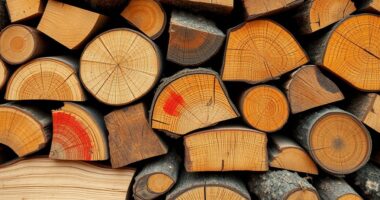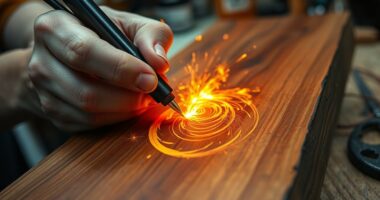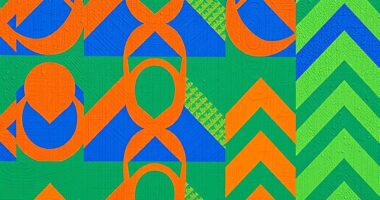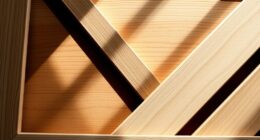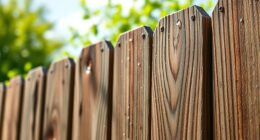To transfer designs for wood burning, you can choose from several effective methods. The graphite paper transfer is simple and precise, perfect for detailed images, while the carbon rubbing technique offers a quick, inexpensive option for simpler designs. Stencils work well for bold, straightforward patterns, and freehand drawing allows for artistic creativity and customization. Whichever method you pick, mastering these techniques will help make sure your project looks professional—keep exploring to discover more tips and tricks.
Key Takeaways
- Graphite paper transfer provides accurate, detailed outlines ideal for complex designs.
- Carbon rubbing is quick and inexpensive but less precise for intricate images.
- Stencils are best for bold, simple shapes, offering control and reducing smudging risk.
- Freehand drawing allows artistic flexibility but requires steady skill and proper surface prep.
- Ensuring stability, ventilation, and careful handling enhances transfer quality and safety.

Transferring designs for wood burning is a crucial step that determines the accuracy and quality of your finished piece. Choosing the right method can make your project easier and result in cleaner, more precise lines. When exploring different techniques comparison, you’ll find several options, each with its own advantages and safety precautions. Your choice depends on your experience level, the complexity of your design, and the tools you have available.
One popular method is graphite paper transfer. It’s straightforward and reliable, especially for detailed or intricate designs. To use it, place the graphite paper between your printout and the wood surface, then trace over the design with a pen or stylus. The graphite leaves a faint but clear outline on the wood, ready for burning. This technique comparison shows that graphite paper offers accuracy and ease, but you should ensure the paper doesn’t shift during tracing to avoid smudges. Safety precautions include working in a well-ventilated area to avoid inhaling graphite dust and avoiding excessive pressure that could damage the wood surface or cause the paper to tear.
Graphite paper transfer is reliable and precise for detailed wood burning designs.
Another common method is carbon transfer, which involves rubbing a soft pencil or charcoal over the back of your printed design, then placing it face down on the wood. You trace over the design’s lines, and the carbon transfers onto the wood underneath. This technique comparison reveals it’s quick and inexpensive but less precise for complex images. You should take safety precautions by wearing a mask if working with charcoal or graphite dust to prevent inhalation. Also, be cautious when handling sharp tools to avoid accidental injury.
The stencil method is perfect for bold, simple designs. You cut out your pattern from cardboard or stencil material and then position it on the wood. Using a pencil or fine marker, trace around the edges to transfer the outline. This approach offers control and reduces the risk of smudging, making it suitable for beginners. When considering safety precautions, ensure your stencil is securely fixed to prevent shifting during tracing. Use a gentle hand to avoid gouging the wood or damaging your stencil, and always work on a stable surface.
Lastly, freehand drawing allows you to directly sketch your design onto the wood with a pencil before burning. This method demands a steady hand and confidence but provides maximum control over your artwork. To ensure safety, keep your tools sharp and handle them carefully. Also, work in a well-ventilated space, especially if you’re sketching with any markers or pens that emit fumes. Proper surface preparation and choosing the right transfer method are essential for achieving high-quality results in wood burning projects. Whichever technique you choose, always prioritize safety precautions to protect yourself and ensure your design transfers accurately, setting a solid foundation for your wood burning project.
Frequently Asked Questions
Can I Reuse Transfer Methods on Different Types of Wood?
Yes, you can reuse transfer methods on different types of wood, but you should consider the wood grain and surface. Transfer paper works well on smooth, soft woods like basswood or pine, but may not adhere properly on rough or dense woods like oak or maple. Always test a small area first to ensure the design transfers cleanly without smudging or tearing, adjusting your technique as needed.
How Do I Prevent Smudging When Transferring Designs?
Prevent pesky smudging by practicing precise placement and patience. Use design transfer tips like lightly tapping or pressing the transfer gently to avoid shifting. Keep your hands steady and work quickly, minimizing contact with the design after placement. To prevent smudging, consider using a fixative spray or a light dusting of powder before burning. These simple steps help keep your design pristine and transfer process smooth, preventing smudges effectively.
Are There Eco-Friendly Transfer Options Available?
Yes, eco-friendly transfer options are available. You can use biodegradable inks and plant-based transfers, which are gentle on the environment and safe for your projects. These options reduce chemical waste and are made from sustainable materials. By choosing plant-based transfers, you support eco-conscious practices while achieving clear, effective designs on wood. Look for suppliers that prioritize biodegradable inks and eco-friendly materials to make your woodworking projects more sustainable.
How Long Do Transferred Designs Typically Last?
Transferred designs typically last for several years if you use proper sealing and finishing techniques. The durability lifespan depends on your chosen transfer method and how well you care for the wood. With a good sealant, your transfer longevity can extend up to 5-10 years, maintaining clear lines and vibrant details. To maximize your design’s lifespan, avoid excessive moisture and direct sunlight, which can cause fading or peeling over time.
Can I Customize Transfer Methods for Intricate Patterns?
You can absolutely customize transfer methods for intricate patterns, tailoring techniques to match pattern complexity. Imagine fine lines and delicate details coming to life on your wood surface—using custom transfer techniques like carbon paper, stencils, or even digital transfers. Adjust pressure, materials, and tools to suit the pattern’s intricacy. With patience and experimentation, you’ll achieve precise, stunning results that highlight even the most complex designs in your wood burning projects.
Conclusion
Now that you know the best methods to transfer your designs, your creativity can shine through like a beacon guiding your way. Whether you choose graphite, carbon paper, or stencil transfer, these techniques are your trusted tools to bring your ideas to life on wood. Think of each method as a bridge, making your vision leap from paper to wood seamlessly. With practice, you’ll turn raw wood into a canvas that tells your unique story.


